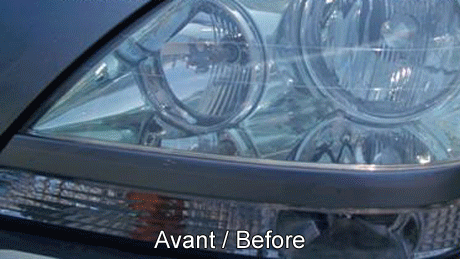
 |
HOME |
SERVICES |
PHOTOS |
CLIENTS |
CONTACT |
VIDEOS |
FRANÇAIS |
 Click to watch video presentation |
Headlight RestorationFull restoration:
Brings the headlights back to original condition and
protects against degradation with the application of a nano-ceramic
coating. Stand alone service: 199.99$ Addon to an interior or exterior detail package: 149.99$
The work takes about 90 minutes to complete. |
|
A few years ago, manufacturers started replacing glass as a basic headlight material by plastic. Plastic has many advantages such as allowing a more aerodynamic design, looking a lot better and being far less dangerous in the case of an accident.
The problem with plastic is that Ultra Violet light makes it turn opaque and yellow. To counter this, manufacturers apply a UV Protective coating on the headlight when the vehicle is built. This coating fails over time and when it does the plastic of the headlight starts to yellow and turn opaque as it is being affected by sunlight.
This process can reduce the amount of light that your headlight emits by up to 50%. This makes it very dangerous to drive at night since they are now projecting a lot less light than they should and visibility is reduced.
We can reverse this process by removing the dead UV protective layer and making the plastic transparent again. Once that is done, we apply a new protective layer on the now restored headlight to prevent it from turning yellow and opaque again.
| Exemple of
our work (click to see the pictures) |
||||
 Headlight restoration on a Honda Accord |
 Backlight restoration |
 Headlight restoration on a Lexus |
||
 Headlight restoration on a Mazda 3 |
 Headlight restoration on a Focus |
 Headlight restoration on a Saab |
||
|
Published on CAA-Quebec's website in 2018: A CAA-Quebec study shows that automobile headlight lenses damaged by harsh weather, abrasives and debris become so opaque that they can reduce lighting effectiveness to half that of headlights in good condition. Tests conducted on a closed track confirm this: a motorist travelling 50 km/h at night will have four more seconds to react to an emergency if the headlights are in good condition and undamaged. A widespread problemTo study the damaged-headlight phenomenon, CAA-Quebec first sent its experts to various public parking lots to look at a representative sample of Quebec’s vehicles. This exercise concluded that 30% of vehicles checked showed obvious signs of headlight opacity, and the problems were very serious in nearly 15% of cases. Results in a controlled environment …Using a luxmeter, CAA-Quebec measured illumination (in other words, the quantity of light received by the object being illuminated) before and after the refurbishment of headlight lenses. The results of these tests, conducted in a closed room with no light source, are surprising. They show a difference in illumination of up to 525% lux or 6 times more. … and on a closed trackOther tests, conducted on a road circuit, also enabled the measurement of the impact of headlight lens opacity on visibility. Black panels of various dimensions were placed at different distances. The results show that the driver of a vehicle with headlights in good condition could see the panels 60 metres sooner than someone driving a vehicle with damaged lenses. The improvement in visibility varied from 92% to 1,200%. For full results of this study, view our video. “When you are driving at night – especially at this time of year with darkness coming earlier – it is essential to see as far ahead as possible in order to be prepared for any eventuality,” says Sophie Gagnon, CAA-Quebec’s Senior Director, Public and Government Relations. “Considering that more than 90% of the information needed when driving a car comes from visual searching, it is fundamental to have optimal vision, especially at the time of year when many children will be walking on our streets for Halloween.” The CAA-Quebec tests were conducted when weather conditions were favourable to driver visibility. It could be even more difficult, for example, to notice a pedestrian who is farther away and at the side of the road when it is snowing or raining heavily. Causes of headlight deteriorationAlthough headlight opacity is more widespread among vehicles that are more than five years old, CAA-Quebec has observed that it can occur in the earlier years of a vehicle’s life. More than age, the material used to make lenses is at issue. Thus, glass headlights on a vehicle that is more than 10 years old may be found to be in excellent shape, whereas headlights made of polycarbonate are more easily damaged by abrasives and debris such as sand, calcium or salt, as well as by sunlight and rain. Low-cost corrective measuresTo restore headlights to like-new condition, CAA-Quebec recommends dealing with a specialized company that renews lenses completely and sustainably, using a polishing technique. A number of products are sold, but their results are not always long-lasting. “Treatments are available to remedy headlight opacity, and they are not expensive,” Ms. Gagnon says. “There is therefore no excuse for tolerating headlights that fail to illuminate the road sufficiently. All drivers win by having better visibility.” |

Click here to book an appointment
| Copyright © 2023. Tous droits réservés. |
HOME |
SERVICES |
PHOTOS |
CLIENTS |
CONTACT |
VIDEOS |
FRANÇAIS |